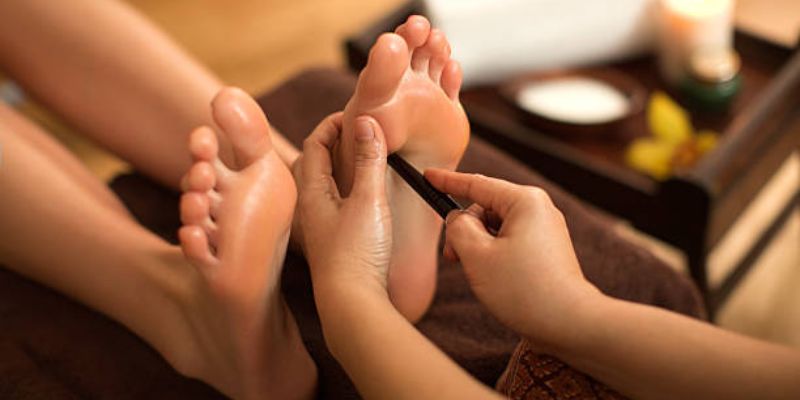
Pain is an experience that touches not only the body, but also the mind and emotional landscape. While many people seek relief through various therapeutic approaches, there is growing appreciation for practices that work through gentle touch, relaxation, and attentive awareness of the body’s signals. Reflexology is one such approach that offers comfort through focused pressure on specific points of the feet. When combined thoughtfully with other healing methods, it can help create a deeper sense of ease and harmony throughout the body.
The essence of reflexology is grounded in presence. Each session encourages the receiver to slow down, shift inward, and notice subtle sensations that might easily be overlooked in daily life. Pain often becomes amplified when tension, stress, and overactive thought patterns accumulate. Reflexology provides a way to guide the body toward softer patterns of response, allowing pain to become less overwhelming and more manageable.
Reflexology as a Supportive Pathway to Comfort
Foot Reflexology in Chennai is often approached not as a standalone cure, but as a gentle companion to other wellness practices. When the feet are touched with intention and awareness, the nervous system begins to unwind. Areas of the foot correspond to broader regions and organ systems within the body, forming a map that helps guide the practitioner’s touch. By applying steady and attentive pressure to these areas, the body may release held tension, shift breathing into a smoother rhythm, and gradually settle into a quieter state.
Pain is not simply a physical sensation. It is shaped by emotional memory, stress levels, sleep patterns, and environment. Reflexology acknowledges this complexity by focusing on the entire experience of the person rather than the location of discomfort alone. Many people notice that when their feet begin to relax, the rest of the body follows. Shoulders loosen. The jaw softens. The breath deepens. These shifts may not remove pain entirely, but they can lessen the intensity and create space for comfort to return.
Reflexology also supports the body’s natural desire to restore balance. Rather than forcing change, the touch invites a response. This quality is what makes reflexology a powerful complement to other pain management methods: it provides a foundation of calm onto which additional therapeutic work can build.
How Reflexology Enhances Massage and Bodywork
Reflexology blends gracefully with massage therapies because both encourage circulation, relaxation, and bodily awareness. When combined with a full-body massage, reflexology can help prepare the body to soften more deeply. The feet are often the gateway to releasing tensions that are woven throughout the rest of the body. A person who begins a session with tight, guarded muscles may find it difficult to receive touch in a calm, receptive way. Starting with the feet can open the door gently.
In certain massage treatments aimed at easing muscle soreness or chronic discomfort, there may be a tendency for the body to brace against pressure. Reflexology can help lessen this reflexive guarding by first guiding the nervous system into a quieter space. Then, when massage or other bodywork methods are applied, the muscles may be more willing to let go, making the work more effective and less effortful.
This combination can also help after a session is complete. Many people find that reflexology extends the feeling of relief beyond the massage table, as the body continues to unwind even once the touch has ended. The mind often carries this relaxation forward, reducing the emotional intensity that can amplify pain.
Reflexology in Daily Well-Being and Routine Care
Pain management does not always happen in a single moment. It is often a gradual journey shaped by habits, movement patterns, emotional stress, and lifestyle. Integrating reflexology into regular wellness routines offers ongoing support. Over time, the body may become more familiar with the sensation of relaxation and more willing to return to it.
Foot Massage in Velachery experiences can be particularly grounding for individuals who carry stress in their lower back, hips, or abdomen. The feet absorb the weight and rhythm of daily life, and when they are cared for, there is often a ripple effect of relief. The touch encourages warmth, circulation, and a deeper connection to the body’s own rhythms.
For those who combine reflexology with gentle stretching, meditation, aromatherapy, or restorative massage, there may be a sense of continuity in care. Reflexology helps set the tone for the body to receive healing rather than resist it. It asks nothing from the body except to soften where it can and release what feels ready to be released.
A Holistic Experience in a Caring Environment
The environment in which reflexology is practiced influences the experience as much as the technique itself. Soft lighting, quiet rooms, and slow, calm gestures help signal to the body that it is safe to relax. The ritual of washing or preparing the feet before a session often feels symbolic, marking a shift from the external world into a personal, inward space.
At Foot Native, this experience is treated with care and respect. The goal is not only comfort during the session but a lasting sense of ease that can follow the individual into daily life. Every foot holds a story of movement, memory, strain, and resilience. Reflexology offers a chance to listen to that story and respond with compassion rather than force.
Encouraging the Body to Heal at Its Own Pace
Pain may not always disappear quickly, and reflexology does not aim to override the body’s natural signals. Instead, it supports the body in finding its equilibrium. By combining reflexology with other therapies, individuals can create a holistic support system that respects both physical and emotional dimensions of pain.
The true value lies in the invitation to slow down, to breathe with awareness, and to trust that the body is capable of finding comfort. Reflexology complements other healing approaches because it works with the body rather than against it. Pain softens when the whole self is acknowledged not just the symptoms.


